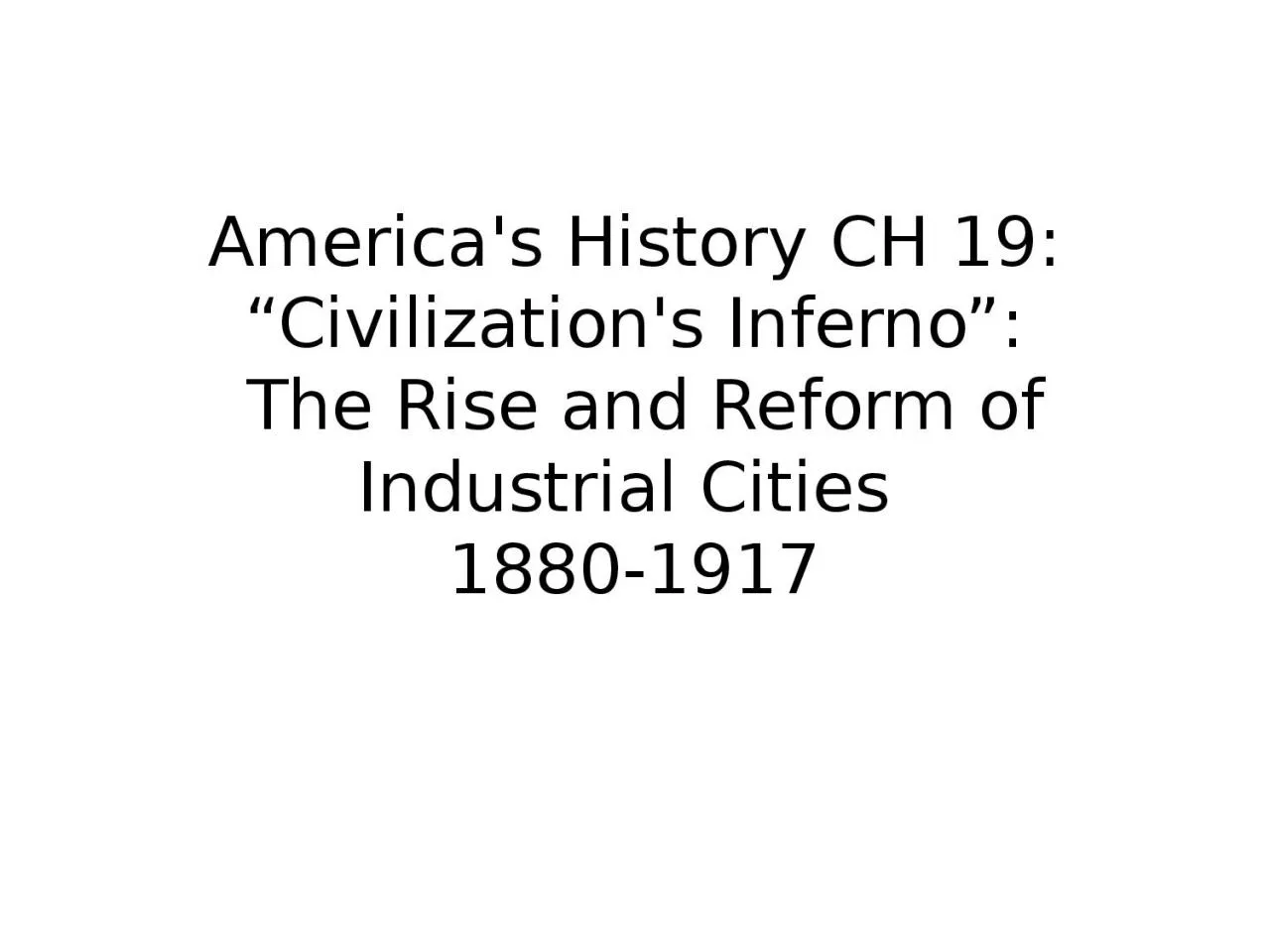

The Rise and Reform of Industrial Cities 18801917 2 New inventions made rapid urban growth possible Elisha O tis inventor of the first passenger elevator Mass transportation moves underground with the first subways first built in Boston MA in 1897 ID: 1018394
Download Presentation The PPT/PDF document "America's History CH 19: “Civilizatio..." is the property of its rightful owner. Permission is granted to download and print the materials on this web site for personal, non-commercial use only, and to display it on your personal computer provided you do not modify the materials and that you retain all copyright notices contained in the materials. By downloading content from our website, you accept the terms of this agreement.
1. America's History CH 19: “Civilization's Inferno”: The Rise and Reform of Industrial Cities 1880-1917
2. 2New inventions made rapid urban growth possibleElisha Otis, inventor of the first passenger elevatorMass transportation moves underground with the first subways first built in Boston MA in 1897. Brooklyn BridgeUrban park designed by Frederick Law OlmsteadLate 19th century skyscraper by the architect Louis Sullivan
3.
4. Ethnic and Class Segregation in Milwaukee, 1850-1890.
5. Ethnic NeighborhoodsThe Three Main Styles of Tenement Flooring
6.
7. 7Role of the media in exposing the problems in AmericaMagazines and newspapers Muckrakers: Upton Sinclair, Ida Tarbell, Jacob Riis, Lincoln Steffens
8. 8NEWSPAPERS AND MAGAZINES EXPOSE THE PROBLEMS OF INDUSTRIAL SOCIETY
9. 9
10. Political machines controlled the activities of political parties in the city. Ward bosses, precinct captains, and the city boss worked to: ensure that their candidates were elected;make sure that city government worked to their advantage. Like a pyramid: local precinct workers and captains at the base, ward bosses in the middle and the city boss at the top City Boss Ward bosses Workers and Captains City Boss = Power broker (most were democrats and many were immigrants themselves)Political machine organizationThe “Boss” (typically the mayor) controlled jobs, business licenses, and influenced the court system. Precinct captains and ward bosses, often 1st or 2nd generation immigrants, helped new immigrants with jobs, housing, and naturalization in exchange for votes. Boss Tweed ran New York City.Role of ImmigrantsImmigrants were the workers who ran the political machine. They offered their loyalty and votes in exchange for favors and solutions to their problems.
11. Graft and ScandalSome political bosses were corrupt and their political machines practiced election fraud by using fake names and voting multiple times to ensure victory.Bribes were common and construction contracts often resulted in kick-backs.Because the police were hired by the boss, there was no close scrutiny.What is Graft?Graft is the illegal use of political influence for personal gain.How did the bosses use graft for their own personal gain? 1. To win elections. 2. To make themselves richer. 3. To finance the operations of the political machine.What are kickbacks?A Kickback is the illegal practice of getting contract workers hired by the bosses to overcharge the city for their services. Then the overpayment would be split between the city boss and the contract-worker.How did the bosses use kickbacks for their own personal gain?The bosses would enrich themselves as well as the machine.
12. 12Problems in the new cities: DiseasePoor sanitation, backed up sewers, crowded poorly ventilated apartments led to the rapid spread of disease.YELLOW FEVER
13. 13Settlement House MovementThe settlement house movement began in the late 1880’s and lasted up through the Great Depression of the 1930’s.Middle-Class educated women and men volunteers lived and worked in settlement houses.Settlement houses were often converted residential buildings in poor urban neighborhoods. By 1910, there were over 400 settlement houses in the U.S.The goal was to improve the lives of poor families by providing amenities and services that were not provided by government.They offered clubs, classes, social gatherings, playgrounds, arts programs, sports and summer camps, clean milk stations, well-baby clinics and other innovative programs.Settlement workers saw their mission as social reform. The settlement houses became laboratories for developing new techniques and offering training in the new field of social work.Pure Food and Drug Act of 1906 First law to regulate manufacturing of food and medicines; prohibited dangerous additives and inaccurate labeling.
14. 14TRIANGLE SHIRTWAIST FIRE LEADS TO REFORM IN WORKING CONDITIONSTRIANGLE SHIRTWAIST COMPANY OCCUPIED THE TOP 3 FLOORSSHIRTWAIST
15. 15Thousands of pounds of highly flammable fabric, rags, and rubbish lay piled on the eighth, ninth, and tenth floors of the Triangle Shirtwaist Factory. And to prevent workers from taking breaks or stealing fabric, the doors to the fire escapes were kept locked.